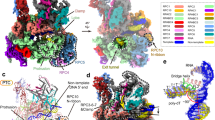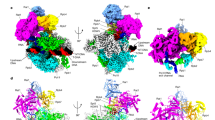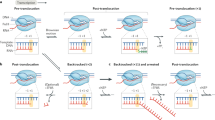Abstract
RNA polymerase II (Pol II) utilizes the same active site for polymerization and intrinsic cleavage. Pol II proofreads the nascent transcript via its intrinsic nuclease activity to maintain high transcriptional fidelity critical for cell growth and viability. The detailed catalytic mechanism of intrinsic cleavage remains unknown. Here, we combined ab initio quantum mechanics/molecular mechanics studies and biochemical cleavage assays to show that Pol II utilizes downstream phosphate oxygen to activate the attacking nucleophile in hydrolysis, while the newly formed 3′-end is protonated through active-site water without a defined general acid. Experimentally, alteration of downstream phosphate oxygen either by 2′-5′ sugar linkage or stereo-specific thio-substitution of phosphate oxygen drastically reduced cleavage rate. We showed by N7-modification that guanine nucleobase is not directly involved as an acid–base catalyst. Our proposed mechanism provides important insights into the intrinsic transcriptional cleavage reaction, an essential step in transcriptional fidelity control.
This is a preview of subscription content, access via your institution
Access options
Access Nature and 54 other Nature Portfolio journals
Get Nature+, our best-value online-access subscription
$29.99 / 30 days
cancel any time
Subscribe to this journal
Receive 12 digital issues and online access to articles
$119.00 per year
only $9.92 per issue
Buy this article
- Purchase on Springer Link
- Instant access to full article PDF
Prices may be subject to local taxes which are calculated during checkout





Similar content being viewed by others
Code availability
Custom computer code used to analyse simulation data is available from the corresponding author on request.
Data availability
The data that support the findings of this study are available from the corresponding author upon reasonable request.
References
Vermulst, M. et al. Transcription errors induce proteotoxic stress and shorten cellular lifespan. Nat. Commun. 6, 8065 (2015).
Borukhov, S., Polyakov, A., Nikiforov, V. & Goldfarb, A. GreA protein: transcription elongation factor from Escherichia coli. Proc. Natl Acad. Sci. USA 89, 8899–8902 (1992).
Borukhov, S., Sagitov, V. & Goldfarb, A. Transcript cleavage factors from E. coli. Cell 72, 459–466 (1993).
Reines, D. Elongation factor-dependent transcript shortening by template-engaged RNA polymerase II. J. Biol. Chem. 267, 3795–3800 (1992).
Lange, U. & Hausner, W. Transcriptional fidelity and proofreading in Archaea and implications for the mechanism of TFS-induced RNA cleavage. Mol. Microbiol. 52, 1133–1143 (2004).
Sigurdsson, S., Dirac-Svejstrup, A. B. & Svejstrup, J. Q. Evidence that transcript cleavage is essential for RNA polymerase II transcription and cell viability. Mol. Cell 38, 202–210 (2010).
Wang, D. et al. Structural basis of transcription: backtracked RNA polymerase II at 3.4 ångstrom resolution. Science 324, 1203–1206 (2009).
Sekine, S., Murayama, Y., Svetlov, V., Nudler, E. & Yokoyama, S. The ratcheted and ratchetable structural states of RNA polymerase underlie multiple transcriptional functions. Mol. Cell 57, 408–421 (2015).
Zenkin, N., Yuzenkova, Y. & Severinov, K. Transcript-assisted transcriptional proofreading. Science 313, 518–520 (2006).
Nielsen, S. & Zenkin, N. Transcript assisted phosphodiester bond hydrolysis by eukaryotic RNA polymerase II. Transcription 4, 209–212 (2013).
Steitz, T. A. & Steitz, J. A. A general two-metal-ion mechanism for catalytic RNA. Proc. Natl Acad. Sci. USA 90, 6498–6502 (1993).
Nakamura, T., Zhao, Y., Yamagata, Y., Hua, Y. & Yang, W. Watching DNA polymerase η make a phosphodiester bond. Nature 487, 196–201 (2012).
Gao, Y. & Yang, W. Capture of a third Mg2+ is essential for catalyzing DNA synthesis. Science 352, 1334–1337 (2016).
Freudenthal, B. D., Beard, W. A., Shock, D. D. & Wilson, S. H. Observing a DNA polymerase choose right from wrong. Cell 154, 157–168 (2013).
Freudenthal, B. D. et al. Uncovering the polymerase-induced cytotoxicity of an oxidized nucleotide. Nature 517, 635–639 (2015).
Vyas, R., Reed, A. J., Tokarsky, E. J. & Suo, Z. Viewing human DNA polymerase β faithfully and unfaithfully bypass an oxidative lesion by time-dependent crystallography. J. Am. Chem. Soc. 137, 5225–5230 (2015).
Reed, A. J. & Suo, Z. Time-dependent extension from an 8-oxoguanine lesion by human DNA polymerase beta. J. Am. Chem. Soc. 139, 9684–9690 (2017).
Jamsen, J. A. et al. Time-lapse crystallography snapshots of a double-strand break repair polymerase in action. Nat. Commun. 8, 253 (2017).
Basu, R. S. & Murakami, K. S. Watching the bacteriophage N4 RNA polymerase transcription by time-dependent soak-trigger-freeze x-ray crystallography. J. Biol. Chem. 288, 3305–3311 (2013).
Molina, R. et al. Visualizing phosphodiester-bond hydrolysis by an endonuclease. Nat. Struct. Mol. Biol. 22, 65–72 (2014).
Sheng, G. et al. Structure-based cleavage mechanism of Thermus thermophilus argonaute DNA guide strand-mediated DNA target cleavage. Proc. Natl Acad. Sci. USA 111, 652–657 (2014).
Samara, N. L. & Yang, W. Cation trafficking propels RNA hydrolysis. Nat. Struct. Mol. Biol. 25, 715–721 (2018).
Yuzenkova, Y. & Zenkin, N. Central role of the RNA polymerase trigger loop in intrinsic RNA hydrolysis. Proc. Natl Acad. Sci. USA 107, 10878–10883 (2010).
Zhang, J., Palangat, M. & Landick, R. Role of the RNA polymerase trigger loop in catalysis and pausing. Nat. Struct. Mol. Biol. 17, 99–104 (2010).
Mishanina, T. V., Palo, M. Z., Nayak, D., Mooney, R. A. & Landick, R. Trigger loop of RNA polymerase is a positional, not acid-base, catalyst for both transcription and proofreading. Proc. Natl Acad. Sci. USA 114, E5103–E5112 (2017).
Warshel, A. & Levitt, M. Theoretical studies of enzymic reactions: dielectric, electrostatic and steric stabilization of the carbonium ion in the reaction of lysozyme. J. Mol. Biol. 103, 227–249 (1976).
Warshel, A. Computer simulations of enzyme catalysis: methods, progress, and insights. Annu. Rev. Biophys. Biomol. Struct. 32, 425–443 (2003).
Riccardi, D. et al. Development of effective quantum mechanical/molecular mechanical (QM/MM) methods for complex biological processes. J. Phys. Chem. B 110, 6458–6469 (2006).
Lu, X. et al. QM/MM free energy simulations: recent progress and challenges. Mol. Simul. 42, 1056–1078 (2016).
Zhou, Y., Wang, S., Li, Y. & Zhang, Y. Born–Oppenheimer ab initio QM/MM molecular dynamics simulations of enzyme reactions. Methods Enzymol. 577, 105–118 (2016).
Hu, P., Wang, S. & Zhang, Y. How do SET-domain protein lysine methyltransferases achieve the methylation state specificity? Revisited by Ab initio QM/MM molecular dynamics simulations. J. Am. Chem. Soc. 130, 3806–3813 (2008).
Hu, P., Wang, S. & Zhang, Y. Highly dissociative and concerted mechanism for the nicotinamide cleavage reaction in Sir2Tm enzyme suggested by ab initio QM/MM molecular dynamics simulations. J. Am. Chem. Soc. 130, 16721–16728 (2008).
Kumar, S., Rosenberg, J. M., Bouzida, D., Swendsen, R. H. & Kollman, P. A. The weighted histogram analysis method for free-energy calculations on biomolecules. I. The method. J. Comput. Chem. 13, 1011–1021 (1992).
Da, L.-T. et al. Bridge helix bending promotes RNA polymerase II backtracking through a critical and conserved threonine residue. Nat. Commun. 7, 11244 (2016).
Gottesman, M. E. & Mustaev, A. Inorganic phosphate, arsenate, and vanadate enhance exonuclease transcript cleavage by RNA polymerase by 2000-fold. Proc. Natl Acad. Sci. USA 115, 2746–2751 (2018).
Patel, N. et al. Flap endonucleases pass 5′-flaps through a flexible arch using a disorder-thread-order mechanism to confer specificity for free 5′-ends. Nucleic Acids Res. 40, 4507–4519 (2012).
Guex, N. & Peitsch, M. C. SWISS-MODEL and the Swiss-PdbViewer: an environment for comparative protein modeling. Electrophoresis 18, 2714–2723 (1997).
Anandakrishnan, R., Aguilar, B. & Onufriev, A. V. H++ 3.0: Automating pK prediction and the preparation of biomolecular structures for atomistic molecular modeling and simulations. Nucleic Acids Res. 40, W537–W541 (2012).
Søndergaard, C. R., Olsson, M. H. M., Rostkowski, M. & Jensen, J. H. Improved treatment of ligands and coupling effects in empirical calculation and rationalization of pKa values. J. Chem. Theory Comput. 7, 2284–2295 (2011).
Huang, X. et al. RNA polymerase II trigger loop residues stabilize and position the incoming nucleotide triphosphate in transcription. Proc. Natl Acad. Sci. USA 107, 15745–15750 (2010).
Becke, A. D. Density-functional exchange-energy approximation with correct asymptotic behavior. Phys. Rev. A 38, 3098–3100 (1988).
Lee, Yang & Parr Development of the Colle–Salvetti correlation-energy formula into a functional of the electron density. Phys. Rev. B 37, 785–789 (1988).
Becke, A. D. Density‐functional thermochemistry. III. The role of exact exchange. J. Chem. Phys. 98, 5648–5652 (1993).
Petersson, G. A. et al. A complete basis set model chemistry. I. The total energies of closed‐shell atoms and hydrides of the first‐row elements. J. Chem. Phys. 89, 2193–2218 (1988).
Petersson, G. A. & Al‐Laham, M. A. A complete basis set model chemistry. II. Open‐shell systems and the total energies of the first‐row atoms. J. Chem. Phys. 94, 6081–6090 (1991).
Dijkstra, E. W. A note on two problems in connexion with graphs. Numer. Math. 1, 269–271 (1959).
Cui, Q. & Elstner, M. Density functional tight binding: values of semi-empirical methods in an ab initio era. Phys. Chem. Chem. Phys. 16, 14368–14377 (2014).
Acknowledgements
We thank Z. Lin for helpful discussions. This work was supported by the Hong Kong Research Grant Council (grant nos. HKUST C6009-15G and AoE/P-705/16 to X.H. and X.L.; 16302214 and T31-605/18-W to X.H.), the King Abdullah University of Science and Technology Office of Sponsored Research (OSR) (OSR-2016-CRG5-3007 to X.H. and X.G.), the Shenzhen Science and Technology Innovation Committee (JCYJ20170413173837121 to X.H.), the Innovation and Technology Commission (ITC-CNERC14SC01 to X.H.), and the National Institutes of Health (grant no. R35-GM127040 to Y.Z.; grant no. GM102362 to D.W.). X.H. is the Padma Harilela Associate Professor of Science. This research made use of the computing resources of the Supercomputing Laboratory at King Abdullah University of Science and Technology.
Author information
Authors and Affiliations
Contributions
J.X. and X.L prepared the proteins and performed the biochemical analyses. C.K.M.T., X.G. and S.W. performed aiQM/MM–MD simulations. H.Y.C. and X.L. performed reverse phase-FPLC purification of thio-substituted oligonucleotides. C.K.M.T., J.X., P.P-H.C., F.K.S., D.W., Y.Z., and X.H. analysed the data. C.K.M.T., J.X., P.P-H.C., D.W., Y.Z., and X.H. wrote the manuscript with inputs from all authors. D.W., Y.Z. and X.H. directed and supervised the research.
Corresponding authors
Ethics declarations
Competing interests
The authors declare no competing interests.
Additional information
Publisher’s note: Springer Nature remains neutral with regard to jurisdictional claims in published maps and institutional affiliations.
Supplementary information
Supplementary Information
Supplementary Notes 1–13, Supplementary Figures 1–19, Supplementary References.
Supplementary Data 1
Initial model.
Supplementary Data 2
RS structure.
Supplementary Data 3
TS1 structure.
Supplementary Data 4
IS structure.
Supplementary Data 5
TS2 structure.
Supplementary Data 6
PS structure.
Rights and permissions
About this article
Cite this article
Tse, C.K.M., Xu, J., Xu, L. et al. Intrinsic cleavage of RNA polymerase II adopts a nucleobase-independent mechanism assisted by transcript phosphate. Nat Catal 2, 228–235 (2019). https://doi.org/10.1038/s41929-019-0227-5
Received:
Accepted:
Published:
Issue Date:
DOI: https://doi.org/10.1038/s41929-019-0227-5



